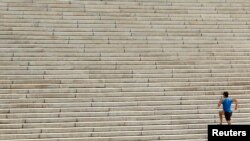Academic success isn’t all about hitting the books. A new study indicates that teenagers who spend time in the gym will see a benefit in the classroom.
Researchers at the Universities of Strathclyde and Dundee in the UK also said the more intense the exercise, the better the performance on standardized tests in English, math and science.
“If moderate to vigorous physical activity does influence academic attainment this has implications for public health and education policy by providing schools and parents with a potentially important stake in meaningful and sustained increases in physical activity,” the researchers write.
For the study, 5,000 children were examined who were all part of the Children of the 90s study, also known as the Avon Longitudinal Study of Parents and Children (ALSPAC). The study tracks the long term health of around 14,000 children born in the UK between 1991 and 1992 in the South West of England.
Their physical activity was monitored, and then standardized tests were given in English, math and science.
Factors likely to influence academic attainment, such as birthweight, a mother’s age at delivery, oily fish intake and smoking during the pregnancy, whether the child had reached puberty, weight, and socioeconomic factors were fully adjusted for.
The analysis showed that at the age of 11, better academic performance across all three subjects was linked to the amount of moderate to vigorous physical activity undertaken. Physical activity benefited girls’ performance in science, in particular.
Academic performance at the age of 13 was similarly linked to how much moderate to vigorous exercise pupils had had at the age of 11.
By the age of 15 to 16, exam results also showed a link to exercise, with an increase in performance for every additional 17 minutes/day (boys) and 12 minutes/day (girls) spent doing more intensive exercise at the age of 11.
Once again, girls’ science results seemed to benefit the most.
Researchers caution that the results concerning girls could be a chance finding, but suggest that the results may also reflect gender differences in the impact of physical activity on the brain.
Their findings prompt the authors to speculate on what might happen to academic performance if children increased the amount of moderate to vigorous physical activity they did to a recommended 60 minutes.
Researchers at the Universities of Strathclyde and Dundee in the UK also said the more intense the exercise, the better the performance on standardized tests in English, math and science.
“If moderate to vigorous physical activity does influence academic attainment this has implications for public health and education policy by providing schools and parents with a potentially important stake in meaningful and sustained increases in physical activity,” the researchers write.
For the study, 5,000 children were examined who were all part of the Children of the 90s study, also known as the Avon Longitudinal Study of Parents and Children (ALSPAC). The study tracks the long term health of around 14,000 children born in the UK between 1991 and 1992 in the South West of England.
Their physical activity was monitored, and then standardized tests were given in English, math and science.
Factors likely to influence academic attainment, such as birthweight, a mother’s age at delivery, oily fish intake and smoking during the pregnancy, whether the child had reached puberty, weight, and socioeconomic factors were fully adjusted for.
The analysis showed that at the age of 11, better academic performance across all three subjects was linked to the amount of moderate to vigorous physical activity undertaken. Physical activity benefited girls’ performance in science, in particular.
Academic performance at the age of 13 was similarly linked to how much moderate to vigorous exercise pupils had had at the age of 11.
By the age of 15 to 16, exam results also showed a link to exercise, with an increase in performance for every additional 17 minutes/day (boys) and 12 minutes/day (girls) spent doing more intensive exercise at the age of 11.
Once again, girls’ science results seemed to benefit the most.
Researchers caution that the results concerning girls could be a chance finding, but suggest that the results may also reflect gender differences in the impact of physical activity on the brain.
Their findings prompt the authors to speculate on what might happen to academic performance if children increased the amount of moderate to vigorous physical activity they did to a recommended 60 minutes.







